Gender and Age Differences in Using Indoor Maps for Wayfinding in Real Environments
Abstract
1. Introduction
- Are there differences between males and females in terms of visual attention and user performance in wayfinding in real indoor environments?
- Are there differences between younger adults and older adults in terms of visual attention and user performance in wayfinding in real indoor environments?
- Are there any cross effects of the gender and age factors on wayfinding in indoor real environments?
2. Related Work
2.1. Gender and Age Differences in Wayfinding
2.2. Wayfinding Research in Indoor Environments
3. Experiment
- Males and females have different visual attention regarding the indoor map and environment and males might perform better than females in indoor wayfinding.
- Younger and elderly adults have significant differences in visual attention and younger adults might have better indoor wayfinding performance than the elderly.
- Gender and age effects impact participants’ wayfinding behavior.
3.1. Participants
3.2. Equipment
3.3. Materials
3.4. Procedure
4. Analysis and Results
4.1. Task 1 (Self-location)
4.1.1. Visual Attention on Map Reading
4.1.2. Visual Attention on Landmarks
4.1.3. Visual Attention Transitions between the Map and the Landmarks
4.2. Task 2 (Route memorization)
4.3. Task 3 (Route following)
4.3.1. General performance
4.3.2. Verbal Protocol
5. Discussion
5.1. Gender Difference
5.2. Age Difference
5.3. Gender and Age Difference
5.4. Implications to Map Design
6. Summary and Further Work
Author Contributions
Funding
Acknowledgments
Conflicts of Interest
References
- Lynch, K. The Image of the City; M.I.T. Press: Cambridge, MA, USA, 1960; pp. 46–68. [Google Scholar]
- Allen, G.L. Spatial abilities, cognitive maps, and wayfinding: Bases for individual differences in spatial cognition and behavior. J. Wayfinding Behav. 1999, 9, 46–80. [Google Scholar]
- Farr, A.C.; Kleinschmidt, T.; Yarlagadda, P.; Mengersen, K. Wayfinding: A simple concept, a complex process. J. Transp. Rev. 2012, 32, 715–743. [Google Scholar] [CrossRef]
- Liao, H.; Dong, W. An Exploratory Study Investigating Gender Effects on Using 3D Maps for Spatial Orientation in Wayfinding. J. Int. J. Geo-Inf. 2017, 6, 60. [Google Scholar] [CrossRef]
- Gartner, G.; Huang, H.; Millonig, A.; Schmidt, M.; Ortag, F. Human-centred Mobile Pedestrian Navigation Systems. J. Mitteilungen Osterreichischen Geogr. Ges. 2012, 153, 237–250. [Google Scholar]
- Kiefer, P.; Giannopoulos, I.; Raubal, M. Where am I? Investigating map matching during selflocalization with mobile eye tracking in an urban environment. J. Trans. GIS 2014, 18, 660–686. [Google Scholar] [CrossRef]
- Koletsis, E.; van Elzakker, C.P.; Kraak, M.J.; Cartwright, W.; Arrowsmith, C.; Field, K. An investigation into challenges experienced when route planning, navigating and wayfinding. J. Int. J. Cartogr. 2017, 3, 4–18. [Google Scholar] [CrossRef]
- Hund, A.M.; Padgitt, A.J. Direction giving and following in the service of wayfinding in a complex indoor environment. J. Environ. Psychol. 2010, 30, 553–564. [Google Scholar] [CrossRef]
- Vanclooster, A.; Nico, V.D.W.; De Maeyer, P. Integrating Indoor and Outdoor Spaces for Pedestrian Navigation Guidance: A Review. J. Trans. GIS 2016, 20, 491–525. [Google Scholar] [CrossRef]
- Lin, C.T.; Huang, T.Y.; Lin, W.J.; Chang, S.Y.; Lin, Y.H.; Ko, L.W.; Hung, D.L.; Chang, E.C. Gender differences in wayfinding in virtual environments with global or local landmarks. J. Environ. Psychol. 2012, 32, 89–96. [Google Scholar] [CrossRef]
- Yang, Y.; Merrill, E.C. Cognitive and Personality Characteristics of Masculinity and Femininity Predict Wayfinding Competence and Strategies of Men and Women. J. Sex Roles 2016, 76, 747–758. [Google Scholar] [CrossRef]
- Golledge, R.G. Human wayfinding and cognitive maps. In The Colonization of Unfamiliar Landscapes; Routledge: London, UK, 1999; pp. 5–45. [Google Scholar]
- Meilinger, T.; Knauff, M. Ask for directions or use a map: A field experiment on spatial orientation and wayfinding in an urban environment. J. Surv. 2008, 53, 13–23. [Google Scholar] [CrossRef]
- Montello, D.R.; Lovelace, K.L.; Golledge, R.G.; Self, C.M. Sex-Related Differences and Similarities in Geographic and Environmental Spatial Abilities. J. Ann. Assoc. Am. Geogr. 2015, 89, 515–534. [Google Scholar] [CrossRef]
- Coluccia, E.; Louse, G. Gender differences in spatial orientation: A review. J. Environ. Psychol. 2004, 24, 329–340. [Google Scholar] [CrossRef]
- Tlauka, M.; Brolese, A.; Pomeroy, D.; Hobbs, W. Gender differences in spatial knowledge acquired through simulated exploration of a virtual shopping centre. J. Environ. Psychol. 2005, 25, 111–118. [Google Scholar] [CrossRef]
- Andersen, N.E.; Dahmani, L.; Konishi, K.; Bohbot, V.D. Eye tracking, strategies, and sex differences in virtual navigation. J. Neurobiol. Learn. Mem. 2012, 97, 81–89. [Google Scholar] [CrossRef] [PubMed]
- Head, D.; Isom, M. Age effects on wayfinding and route learning skills. J. Behav. Brain Res. 2010, 209, 49–58. [Google Scholar] [CrossRef] [PubMed]
- Taillade, M.; Sauzéon, H.; Pala, P.A.; Déjos, M.; Larrue, F.; Gross, C.; N’Kaoua, B. Age-Related Wayfinding Differences in Real Large-Scale Environments: Detrimental Motor Control Effects during Spatial Learning Are Mediated by Executive Decline? PLoS ONE 2013, 8, e67193. [Google Scholar] [CrossRef] [PubMed]
- Taillade, M.; Sauzéon, H.; Dejos, M.; Arvind Pala, P.; Larrue, F.; Wallet, G.; Gross, C.; N’Kaoua, B. Executive and memory correlates of age-related differences in wayfinding performances using a virtual reality application. J. Aging Neuropsychol. Cogn. 2013, 20, 298–319. [Google Scholar] [CrossRef] [PubMed]
- Adamo, D.E.; Briceño, E.M.; Sindone, J.A.; Alexander, N.B.; Moffat, S. Age differences in virtual environment and real world path integration. J. Front. Aging Neurosci. 2012, 4, 26. [Google Scholar] [CrossRef]
- Taillade, M.; N'Kaoua, B.; Sauzéon, H. Age-Related Differences and Cognitive Correlates of Self-Reported and Direct Navigation Performance: The Effect of Real and Virtual Test Conditions Manipulation. J. Front. Psychol. 2016, 6, 2034. [Google Scholar] [CrossRef]
- Brown, L.N.; Lahar, C.J.; Mosley, J.L. Age and Gender-Related Differences in Strategy Use for Route Information A “Map-Present” Direction-Giving Paradigm. J. Environ. Behav. 1998, 30, 123–143. [Google Scholar] [CrossRef]
- Khanan, M.F.A. Individual differences in the tourist wayfinding decision making process. In Proceedings of the 14th International Symposium on Spatial Data Handling, Hong Kong, China, 26–28 May 2010; pp. 319–324. [Google Scholar]
- Lawton, C.A. Individual- and gender-related differences in indoor wayfinding. J. Environ. Behav. 1996, 28, 204–219. [Google Scholar] [CrossRef]
- Vanclooster, A.; Ooms, K.; Viaene, P.; Fack, V.; Van de Weghe, N.; De Maeyer, P. Evaluating suitability of the least risk path algorithm to support cognitive wayfinding in indoor spaces: An empirical study. J. Appl. Geogr. 2014, 53, 128–140. [Google Scholar] [CrossRef]
- Li, H.; Giudice, N.A. The effects of 2D and 3D maps on learning virtual multi-level indoor environments. In Proceedings of the 1st ACM SIGSPATIAL International Workshop on MapInteraction, Orlando, FL, USA, 5–8 November 2013; pp. 7–12. [Google Scholar]
- Burigat, S.; Chittaro, L.; Sioni, R. Mobile Three-Dimensional Maps for Wayfinding in Large and Complex Buildings: Empirical Comparison of First-Person versus Third-Person Perspective. J. IEEE Trans. Hum.-Mach. Syst. 2017, 47, 1029–1039. [Google Scholar] [CrossRef]
- Trine, B.; Thorsteinn, S. Wayfinding by Means of Maps in Real-world Settings: A Critical Review. J. Navig. 2016, 70, 263–275. [Google Scholar]
- Bedi, S.; Webb, J. Through the Students’ Lens: Photographic Methods for Research in Library Spaces. J. Evid. Based Libr. Inf. Pract. 2017, 12, 15–35. [Google Scholar] [CrossRef]
- Wang, W.; Huang, H.; Gartner, G. Considering Existing Indoor Navigational Aids in Navigation Services. In International Conference on Spatial Information Theory; Springer: Cham, Switzerland, 2017; pp. 179–189. [Google Scholar]
- Mandel, L.H. Wayfinding research in library and information studies: State of the field. J. Evid. Based Libr. Inf. Pract. 2017, 12, 133–148. [Google Scholar] [CrossRef]
- Lscher, C.; Büchner, S.J.; Meilinger, T. Adaptivity of wayfinding strategies in a multi-building ensemble: The effects of spatial structure, task requirements, and metric information. J. Environ. Psychol. 2009, 29, 208–219. [Google Scholar]
- Zhang, H.; Ye, C. An Indoor Wayfinding System Based on Geometric Features Aided Graph SLAM for the Visually Impaired. J. IEEE Trans. Neural Syst. Rehabil. Eng. 2017, 25, 1592–1604. [Google Scholar] [CrossRef] [PubMed]
- Kinsley, K.M.; Dan, S.; Spitler, J. GoPro as an ethnographic tool: A wayfinding study in an academic library. J. Access Serv. 2016, 13, 7–23. [Google Scholar] [CrossRef]
- Steinke, T. Eye movement studies in cartography and related fields. J. Cartogr. 1987, 24, 197–221. [Google Scholar] [CrossRef]
- Liao, H.; Dong, W.; Peng, C.; Liu, H. Exploring differences of visual attention in pedestrian navigation when using 2D maps and 3D geo-browsers. J. Cartogr. Geogr. Inf. Sci. 2017, 44, 474–490. [Google Scholar] [CrossRef]
- Kiefer, P.; Straub, F.; Raubal, M. Location-Aware Mobile Eye Tracking for the Explanation of Wayfinding Behavior. In Proceedings of the AGILE’2012 International Conference on Geographic Information Science, Avignon, France, 24–27 April 2012. [Google Scholar]
- Brügger, A.; Richter, K.; Fabrikant, S.I. Distributing Attention between Environment and Navigation System to Increase Spatial Knowledge Acquisition during Assisted Wayfinding. In International Conference on Spatial Information Theory; Springer: Cham, Switzerland, 2017; pp. 19–22. [Google Scholar]
- Schrom-Feiertag, H.; Settgast, V.; Seer, S. Evaluation of indoor guidance systems using eye tracking in an immersive virtual environment. J. Spat. Cogn. Comput. 2016, 17, 163–183. [Google Scholar] [CrossRef]
- Wechsler, D. Wechsler Adult Intelligence Scale; Springer: New York, NY, USA, 2013. [Google Scholar]
- Hund, A.M.; Schmettow, M.; Noordzij, M.L. The impact of culture and recipient perspective on direction giving in the service of wayfinding. J. Environ. Psychol. 2012, 32, 327–336. [Google Scholar] [CrossRef]
- Wenczel, F.; Hepperle, L.; StãLpnagel, R.V. Gaze behavior during incidental and intentional navigation in an outdoor environment. J. Spat. Cogn. Comput. 2016, 17, 121–142. [Google Scholar] [CrossRef]
- Lawton, C.A.; Kallai, J. Gender Differences in Wayfinding Strategies and Anxiety about Wayfinding: A Cross-Cultural Comparison. Sex Roles 2002, 47, 389–401. [Google Scholar] [CrossRef]
- Coulombe, D. Two-way ANOVA with and without repeated measurements, tests of simple main effects, and multiple comparisons for microcomputers. J. Behav. Res. Methods Instrum. Comput. 1984, 16, 397–398. [Google Scholar] [CrossRef]
- Coluccia, E.; Iosue, G.; Brandimonte, M.A. The relationship between map drawing and spatial orientation abilities: A study of gender differences. J. Environ. Psychol. 2007, 27, 135–144. [Google Scholar] [CrossRef]
- Harrel, W.A.; Bowlby, J.W.; Hall-Hoffarth, D.H. Directing wayfinders with maps: The effects of gender, age, route complexity, and familiarity with the environment. J. Environ. Psychol. 2000, 140, 169–179. [Google Scholar] [CrossRef]
- Avery, R.J. Determinants of search for nondurable goods: An empirical assessment of the economics of information theory. J. Consum. Aff. 1996, 30, 390–421. [Google Scholar] [CrossRef]
- Dogu, U.; Erkip, F. Spatial factors affecting wayfinding and orientation: A case study in a shopping mall. J. Environ. Behav. 2000, 32, 731–755. [Google Scholar] [CrossRef]
- Chebat, J.C.; Gélinas-Chebat, C.; Therrien, K. Gender-related wayfinding time of mall shoppers. J. Bus. Res. 2008, 61, 1076–1082. [Google Scholar] [CrossRef]
- Babin, B.J.; Boles, J.S.; Griffin, M. The Moderating Role of Service Environment on the Customer Share → Customer Commitment Relationship. In New Meanings for Marketing in a New Millennium; Springer: Cham, Switzerland, 2015; pp. 266–271. [Google Scholar]
- Monacelli, A.M.; Cushman, L.A.; Kavcic, V.; Duffy, C.J. Spatial disorientation in Alzheimer’s disease the remembrance of things passed. Neurology 2003, 61, 1491–1497. [Google Scholar] [CrossRef] [PubMed]
- Morganti, F.; Riva, G. Virtual reality as allocentric/egocentric technology for the assessment of cognitive decline in the elderly. J. Stud. Health Technol. Inform. 2014, 196, 278–284. [Google Scholar]
- Credé, S.; Fabrikant, S.I.; Thrash, T.; Hölsche, C. Do Skyscrapers Facilitate Spatial Learning Under Stress? On the Cognitive Processing of Global Landmarks. In International Conference on Spatial Information Theory; Springer: Cham, Switzerland, 2017; pp. 27–29. [Google Scholar]
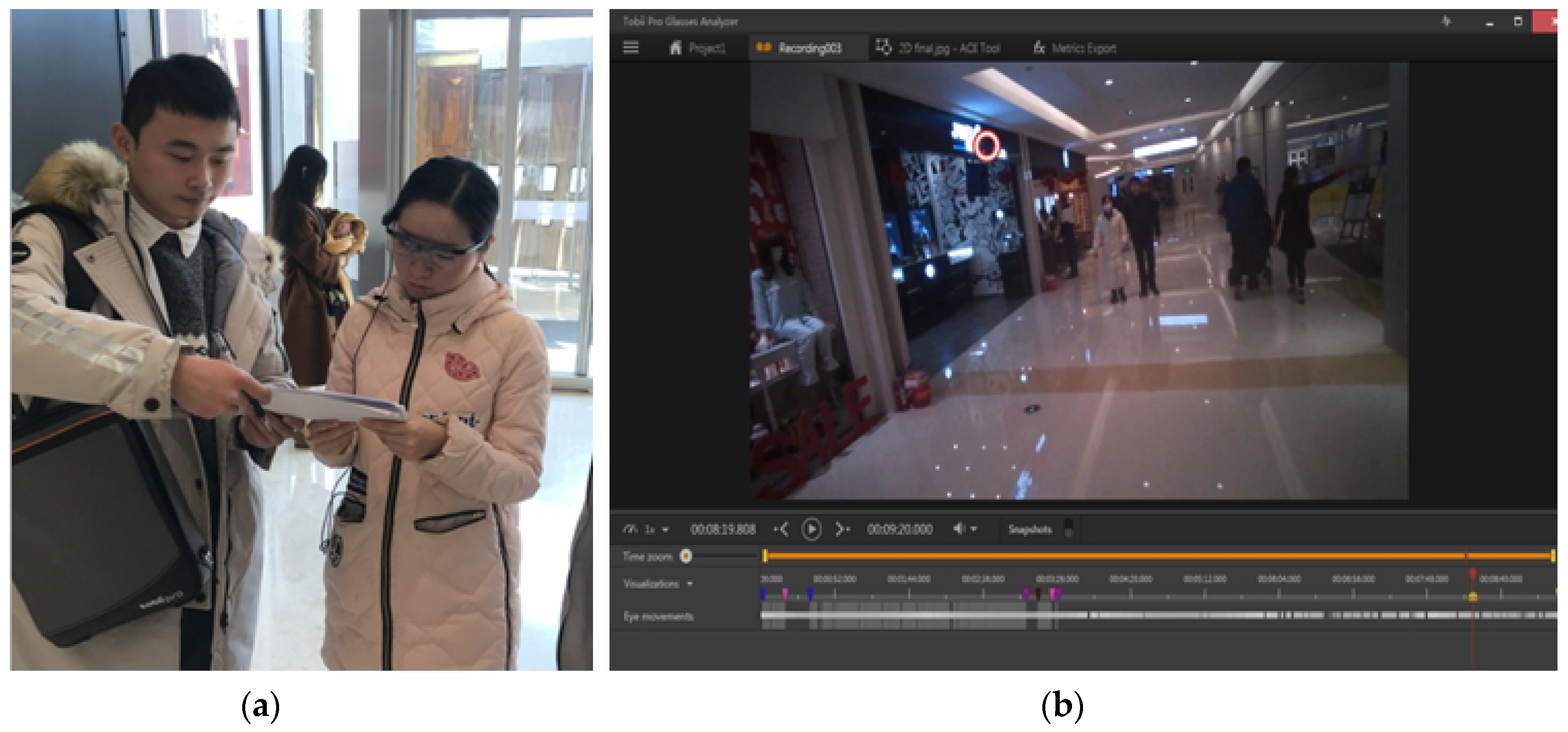
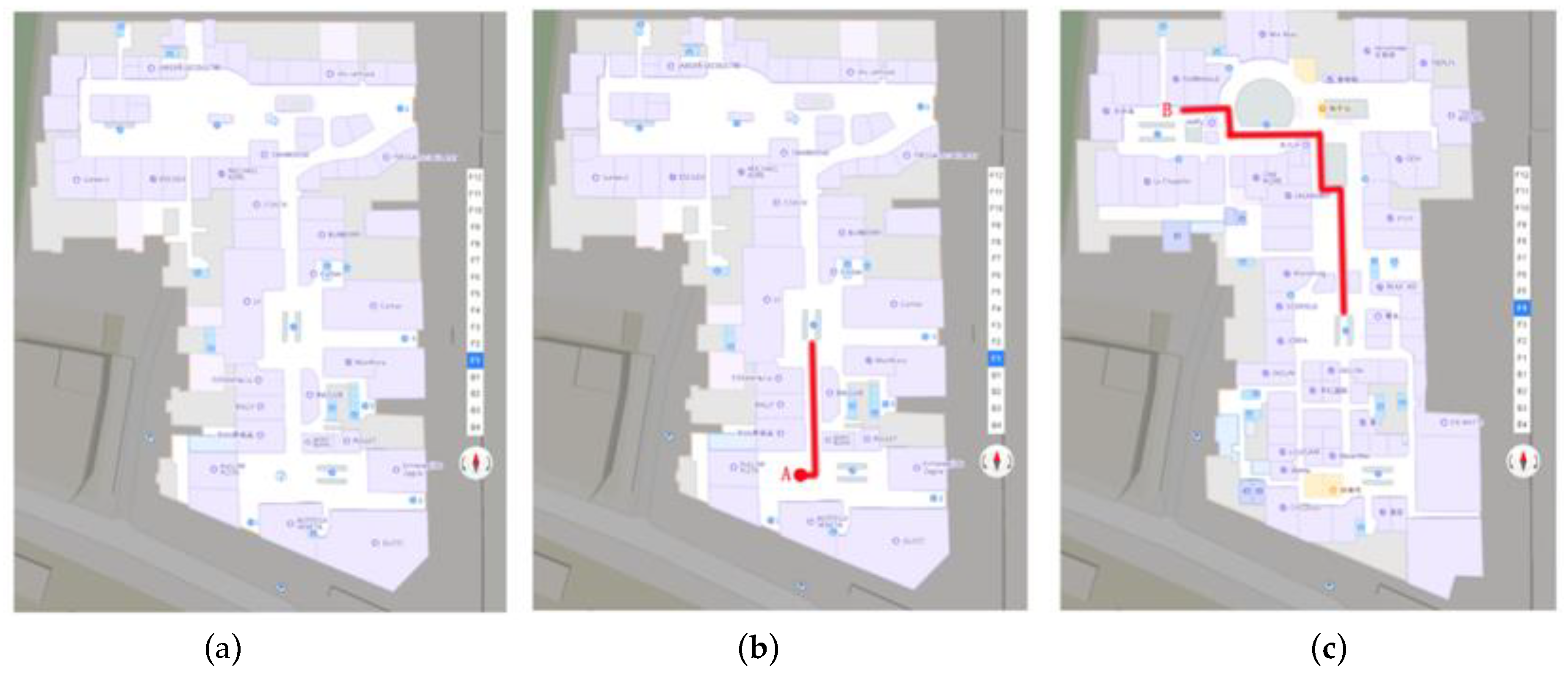


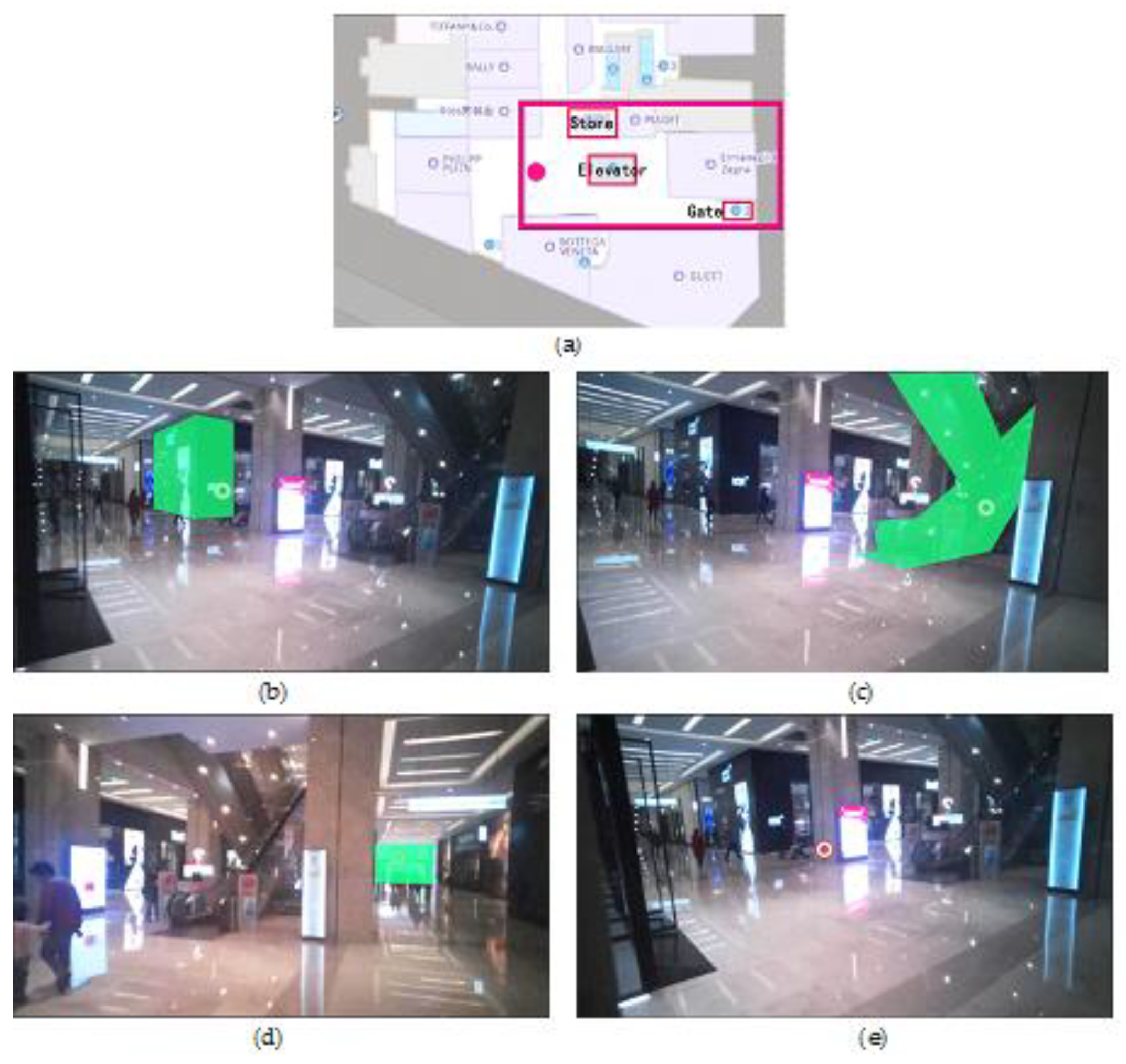


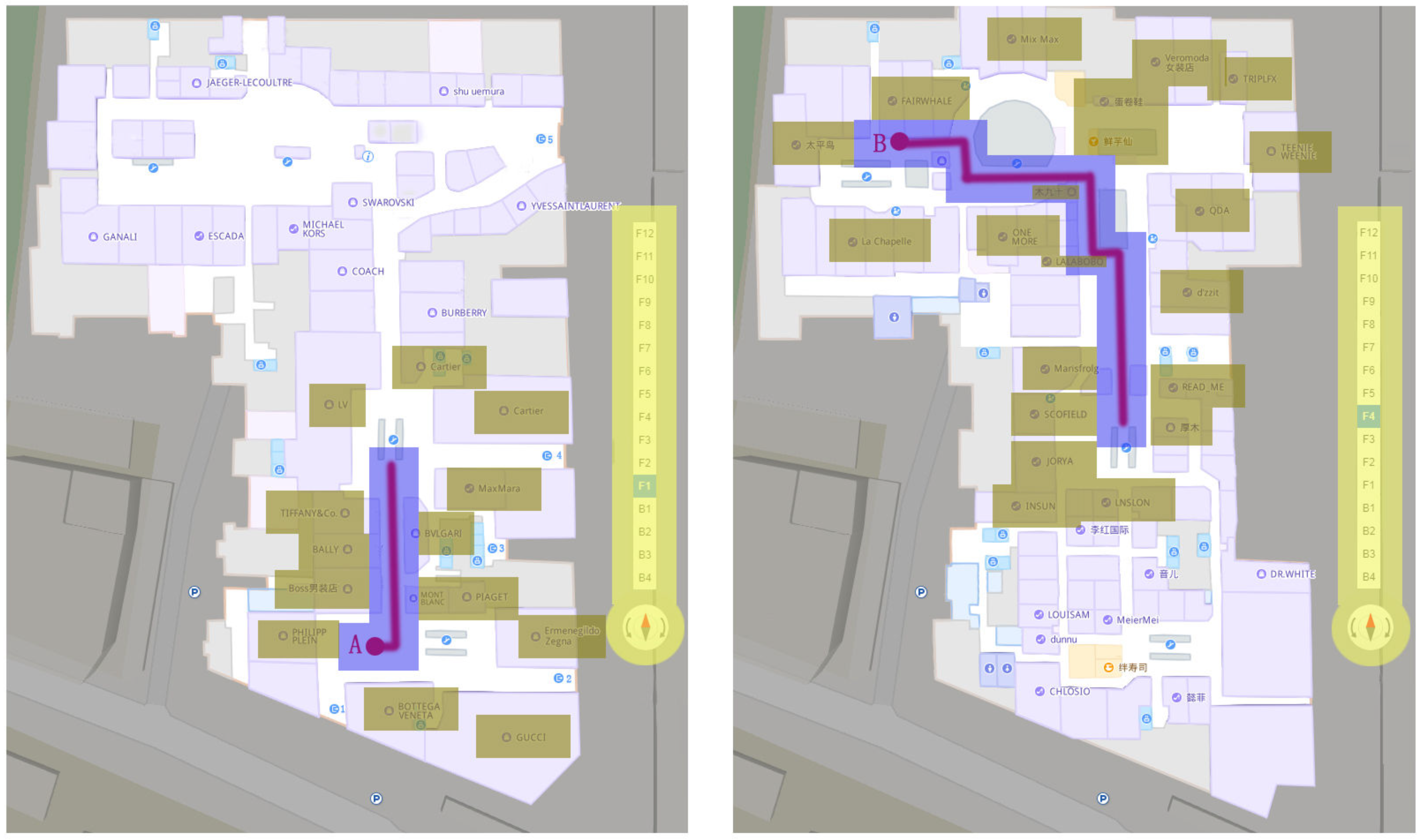

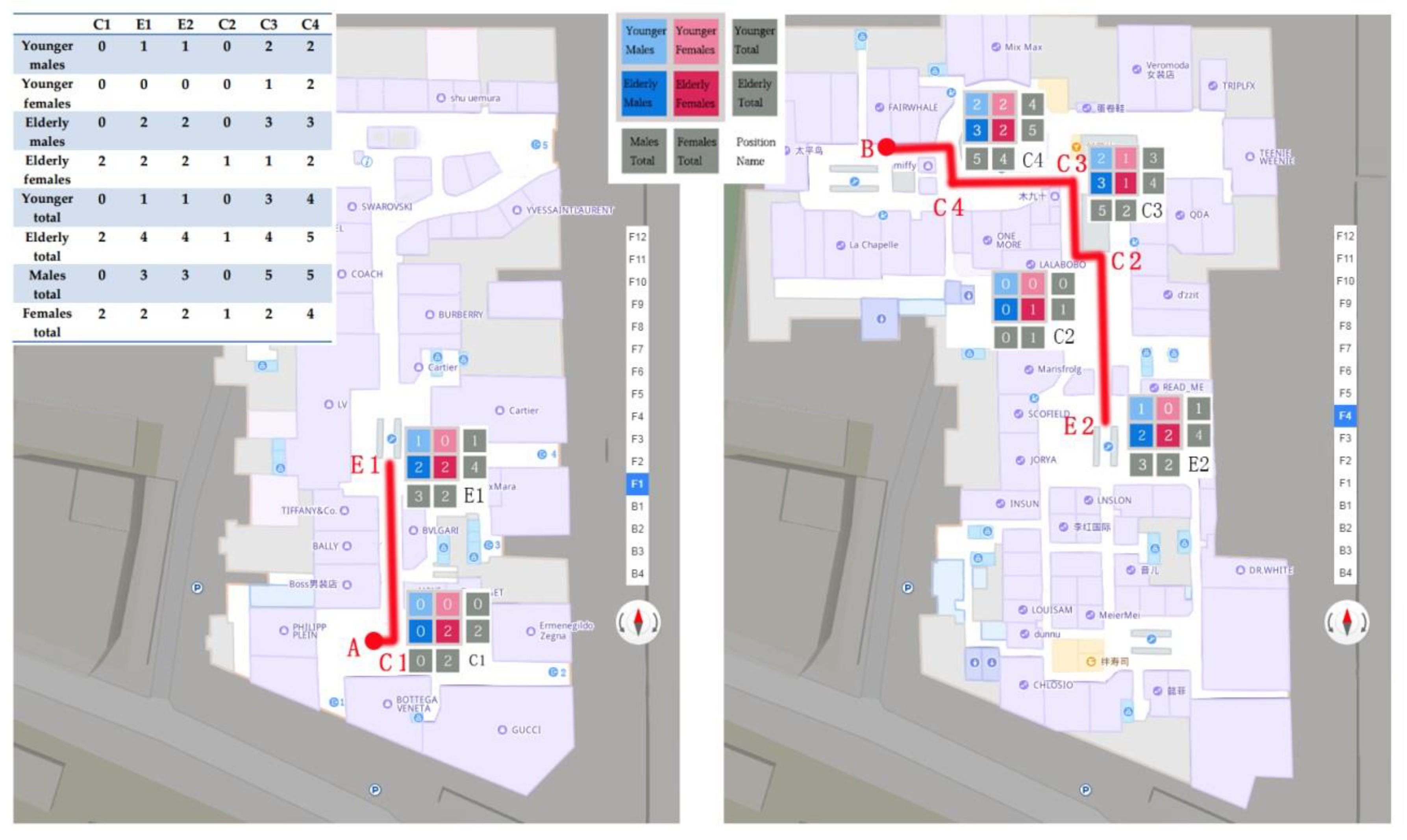
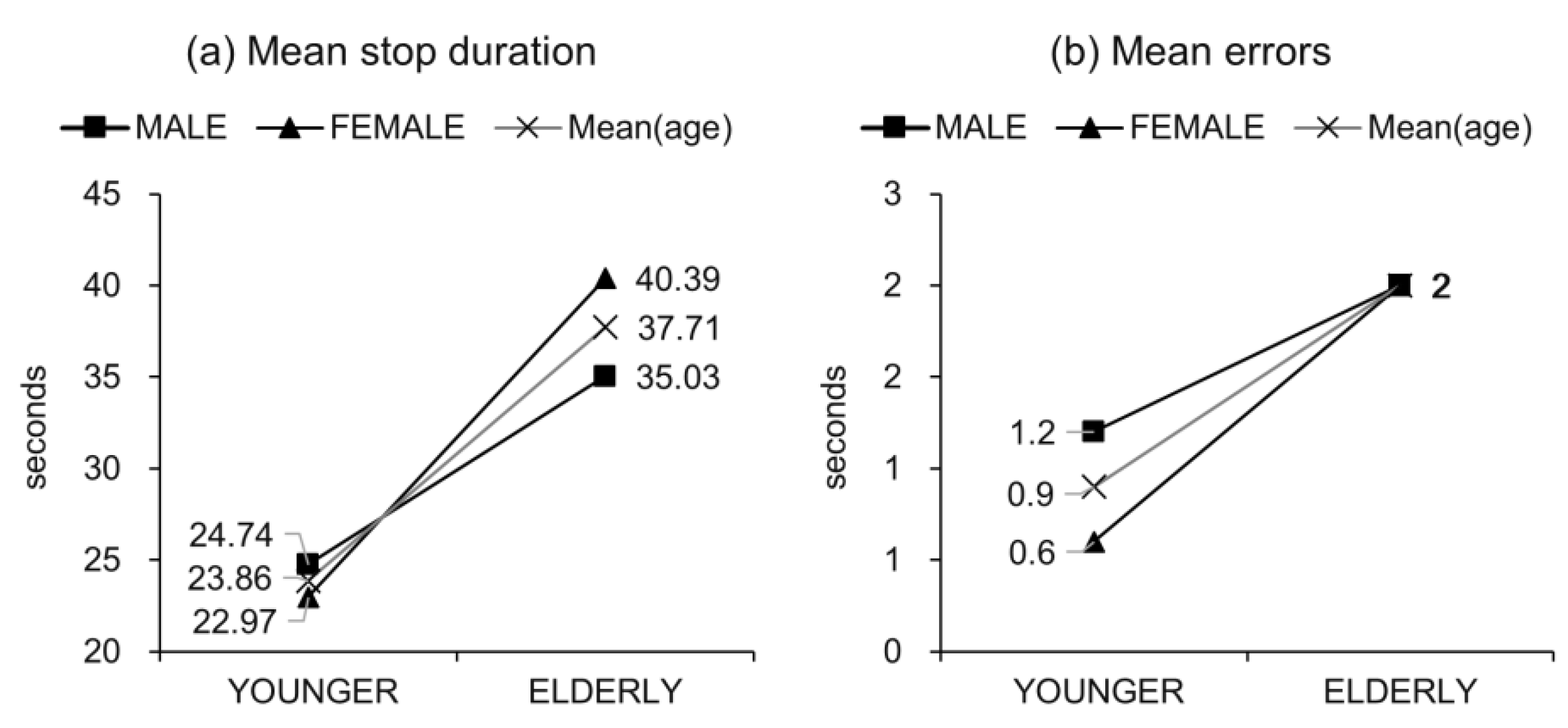
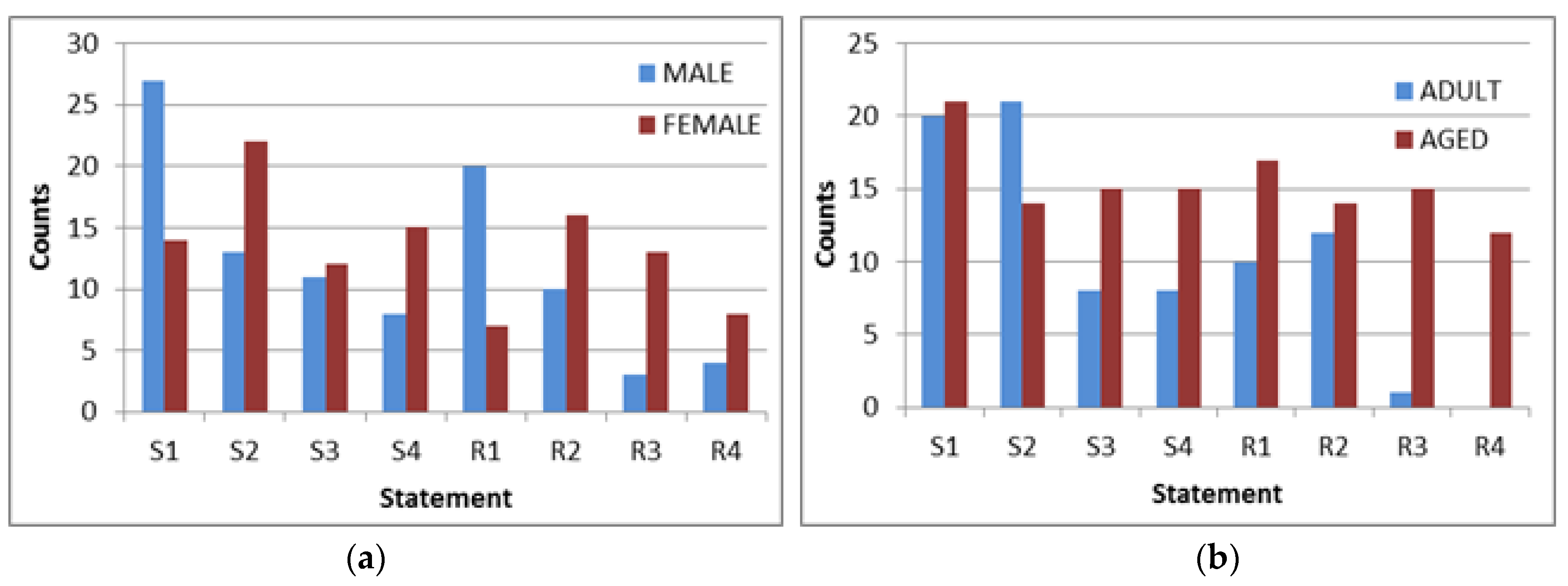
| Metric | Definition |
|---|---|
| First AOI fixation time (seconds) | Time before the first fixation on AOI |
| Map reading duration (seconds) | Total fixation duration on the indoor map |
| Percent of fixations spent on map (%) | percentage of fixation count on the indoor map |
| MALE | FEMALE | Mean (age) | Gender | Age | Gender X Age | ||||
|---|---|---|---|---|---|---|---|---|---|
| Map reading: | M | SD | M | SD | M | SD | ANOVA | ANOVA | ANOVA |
| First AOI fixation time | F(1,19) = 1.03, p > 0.05, = 0.061 | F(1,19) = 7.25, p < 0.05*, = 0.312 | F(1,19) = 9.28, p < 0.01**, = 0.378 | ||||||
| YOUNGER | 18.29 | 5.01 | 21.39 | 7.57 | 19.84 | 6.27 | |||
| ELDERLY | 28.06 | 11.15 | 33.08 | 10.53 | 30.57 | 10.56 | |||
| Mean (gender) | 23.18 | 9.64 | 27.23 | 10.61 | |||||
| Map reading duration | F(1,19) = 0.87, p > 0.05, = 0.051 | F(1,19) = 8.47, p < 0.05*, = 0.346 | F(1,19) = 9.69, p < 0.01**, = 0.443 | ||||||
| YOUNGER | 26.40 | 9.50 | 28.50 | 8.04 | 27.45 | 8.37 | |||
| ELDERLY | 40.96 | 15.69 | 50.57 | 19.78 | 45.77 | 17.58 | |||
| Mean (gender) | 33.68 | 14.44 | 39.54 | 18.39 | |||||
| % of fixation on map | F(1,19) = 0.07, p > 0.05, | F(1,19) = 0.49, p > 0.05, | F(1,19) = 0.93, p > 0.05, | ||||||
| YOUNGER | 0.85 | 0.07 | 0.88 | 0.05 | 0.86 | 0.06 | |||
| ELDERLY | 0.84 | 0.07 | 0.83 | 0.10 | 0.84 | 0.08 | |||
| Mean(gender) | 0.85 | 0.07 | 0.85 | 0.08 | |||||
| First AOI fixation time | Map reading duration | |||||||
|---|---|---|---|---|---|---|---|---|
| Gender | Age(I) | Age(J) | MD(I-J) | SE | Sig. | MD(I-J) | SE | Sig. |
| female | elderly | younger | 11.69 | 5.64 | p > 0.05 | 22.07 | 8.90 | p > 0.05 |
| male | elderly | younger | 9.77 | 5.64 | p > 0.05 | 14.56 | 8.90 | p > 0.05 |
| Age | Gender(I) | Gender(J) | ||||||
| elderly | female | male | 5.01 | 5.64 | p < 0.05* | 9.61 | 8.90 | p < 0.05* |
| younger | female | male | 3.09 | 5.64 | p > 0.05 | 2.10 | 8.90 | p < .05* |
| Visual attention on landmark | MALE | FEMALE | Mean (age) | Gender | Age | Gender X Age | |||
| M | SD | M | SD | M | SD | ANOVA | ANOVA | ANOVA | |
| Store (in percentage) | F(1,19) = 0.41, p > 0.05, = 0.025 | F(1,19) = 0.71, p < 0.05*, = 0.042 | F(1,19) = 0.46, p < 0.05*, = 0.009 | ||||||
| YOUNGER | 0.68 | 0.14 | 0.69 | 0.09 | 0.68 | 0.12 | |||
| ELDERLY | 0.75 | 0.17 | 0.79 | 0.06 | 0.77 | 0.12 | |||
| Mean (gender) | 0.71 | 0.15 | 0.75 | 0.07 | |||||
| Elevator (in percentage) | F(1,19) = 3.34, p > 0.05, = 0.173 | F(1,19) = 4.68, p > 0.05, = 0.226 | F(1,19) = 5.25, p > 0.05, = 0.247 | ||||||
| YOUNGER | 0.10 | 0.13 | 0.08 | 0.09 | 0.09 | 0.10 | |||
| ELDERLY | 0.08 | 0.07 | 0.06 | 0.07 | 0.07 | 0.06 | |||
| Mean (gender) | 0.09 | 0.10 | 0.07 | 0.07 | |||||
| Door (in percentage) | F(1,19) = 0.05, p > 0.05, = 0.003 | F(1,19) = 1.89, p > 0.05, = 0.106 | F(1,19) = 0.99, p > 0.05, = 0.034 | ||||||
| YOUNGER | 0.12 | 0.74 | 0.16 | 0.36 | 0.14 | 0.10 | |||
| ELDERLY | 0.06 | 1.09 | 0.04 | 0.55 | 0.05 | 0.08 | |||
| Mean (gender) | 0.09 | 0.10 | 0.10 | 0.07 | |||||
| Others (in percentage) | F(1,19) = 2.84, p > 0.05, = 0.151 | F(1,19) = 1.12, p > 0.05, = 0.065 | F(1,19) =1.56, p > 0.05, = 0.089 | ||||||
| YOUNGER | 0.10 | 0.30 | 0.07 | 0.16 | 0.09 | 0.05 | |||
| ELDERLY | 0.11 | 0.36 | 0.11 | 1.05 | 0.11 | 0.04 | |||
| Mean (gender) | 0.11 | 0.05 | 0.10 | 0.06 | |||||
| Total fixation duration | F(1,19) = 0.09, p > 0.05, = 0.006 | F(1,19) = 8.01, p < 0.05*, = 0.334 | F(1,19) =0.39, p > 0.05, = 0.024 | ||||||
| YOUNGER | 4.60 | 1.91 | 4.12 | 4.43 | 4.26 | 1.93 | |||
| ELDERLY | 7.98 | 2.15 | 9.42 | 4.37 | 8.70 | 4.21 | |||
| Mean (gender) | 6.29 | 3.67 | 6.77 | 4.28 | |||||
| Fixation duration | MALE | FEMALE | Mean(age) | Gender | Age | Gender X Age | |||
| M | SD | M | SD | M | SD | ANOVA | ANOVA | ANOVA | |
| Landmark | F(1,19) = 8.17, p < 0.05*, = 0.338 | F(1,19) = 17.84, p < 0.001*** = 0.527 | F(1,19) = 14.74, p < 0.001***, = 0.512 | ||||||
| YOUNGER | 12.62 | 1.96 | 16.32 | 2.14 | 14.47 | 2.75 | |||
| ELDERLY | 18.54 | 5.15 | 24.13 | 4.24 | 21.34 | 5.33 | |||
| Mean (gender) | 15.58 | 4.82 | 20.23 | 5.19 | |||||
| Route | F(1,19) = 1.22, p > 0.05, = 0.071 | F(1,19) = 15.81, p < 0.001***, = 0.497 | F(1,19) = 0.25, p > 0.05, = 0.015 | ||||||
| YOUNGER | 15.05 | 3.58 | 12.41 | 3.46 | 13.73 | 3.60 | |||
| ELDERLY | 20.76 | 4.90 | 19.77 | 2.30 | 20.26 | 3.65 | |||
| Mean (gender) | 17.90 | 5.04 | 16.09 | 4.76 | |||||
| Legend | F(1,19) = 6.31, p < 0.05*, = 0.283 | F(1,19) = 18.50, p < 0.001***, = 0.536 | F(1,19) = 13.45, p < 0.01**, = 0.431 | ||||||
| YOUNGER | 6.25 | 2.64 | 7.93 | 2.89 | 7.09 | 2.76 | |||
| ELDERLY | 9.78 | 1.03 | 12.74 | 2.44 | 11.26 | 2.59 | |||
| Mean (gender) | 8.02 | 2.67 | 10.34 | 3.57 | |||||
| Total | F(1,19) = 2.93, p > 0.05, = 0.155 | F(1,19) = 33.11, p < 0.001***, = 0.674 | F(1,19) = 15.87, p < 0.01**, = 0.378 | ||||||
| YOUNGER | 34.63 | 5.92 | 37.4 | 7.48 | 36.02 | 6.53 | |||
| ELDERLY | 49.79 | 7.89 | 57.53 | 5.90 | 53.66 | 7.73 | |||
| Mean (gender) | 42.21 | 10.35 | 47.46 | 12.36 | |||||
| Landmark | Legend | Total | |||||||||
|---|---|---|---|---|---|---|---|---|---|---|---|
| Gender | Age(I) | Age(J) | MD(I-J) | SE | Sig. | MD(I-J) | SE | Sig. | MD(I-J) | SE | Sig. |
| female | elderly | younger | 7.85 | 2.34 | p < 0.05* | 4.87 | 1.53 | p < 0.05* | 20.73 | 4.49 | p < 0.05* |
| male | elderly | younger | 6.10 | 2.34 | p > 0.05 | 3.70 | 1.53 | p > 0.05 | 15.12 | 4.49 | p > 0.05 |
| Age | Gender(I) | Gender(J) | |||||||||
| elderly | female | male | 5.46 | 2.34 | p < 0.01** | 3.27 | 1.53 | p < 0.01** | 7.77 | 4.49 | p < 0.01** |
| younger | female | male | 3.71 | 2.34 | p < 0.05* | 2.10 | 1.53 | p < 0.05* | 2.17 | 4.49 | p < 0.01** |
| Metric | Definition |
|---|---|
| stop duration | The time the participants spent to make a decision at decision points (at elevator and corner) |
| error count | The number of incorrect decisions the participants made at decision points (at elevator and corner) |
| MALE | FEMALE | Mean(age) | Gender | Age | Gender X Age | ||||
|---|---|---|---|---|---|---|---|---|---|
| General performance | M | SD | M | SD | M | SD | ANOVA | ANOVA | ANOVA |
| Mean stop duration | F(1,19) = 0.15, p > 0.05, = 0.048 | F(1,19) =8.43, p < 0.01**, = 0.493 | F(1,19) = 1.22, p > 0.05, = 0.087 | ||||||
| YOUNGER | 24.74 | 6.61 | 22.97 | 10.07 | 23.86 | 8.09 | |||
| ELDERLY | 35.03 | 16.75 | 40.39 | 8.96 | 37.71 | 12.98 | |||
| Mean (gender) | 29.89 | 13.17 | 31.68 | 12.85 | |||||
| Mean errors | F(1,19) = 0.26, p > 0.05, = 0.020 | F(1,19) = 3.88, p > 0.05, = 0.194 | F(1,19) = 2.24, p > 0.05, = 0.036 | ||||||
| YOUNGER | 1.20 | 0.89 | 0.60 | 0.45 | 0.90 | 0.70 | |||
| ELDERLY | 2.00 | 0.71 | 2.00 | 0.84 | 2.00 | 1.17 | |||
| Mean (gender) | 1.60 | 0.99 | 1.30 | 1.11 | |||||
| Statement: | Example(s) |
| S1: Positive statement regarding landmarks | This is the LV store near the elevator. |
| S2: Positive statement regarding direction | I turn left at this corner. I go west at this position. |
| S3: Negative statement regarding landmarks | Where is the Xian Yuxian store? |
| S4: Negative statement regarding direction | Should I turn left or right? |
| Response: | Example(s) |
| R1: Positive response regarding landmarks | Yes, I find the route by recognizing the Xian Yuxian store. |
| R2: Positive response regarding direction | No, I turn west at this position. |
| R3: Negative response regarding landmarks | Sorry, I forget the store name. |
| R4 Negative response regarding direction | Well, I am not sure whether to turn right or left. |
© 2018 by the authors. Licensee MDPI, Basel, Switzerland. This article is an open access article distributed under the terms and conditions of the Creative Commons Attribution (CC BY) license (http://creativecommons.org/licenses/by/4.0/).
Share and Cite
Wang, C.; Chen, Y.; Zheng, S.; Liao, H. Gender and Age Differences in Using Indoor Maps for Wayfinding in Real Environments. ISPRS Int. J. Geo-Inf. 2019, 8, 11. https://doi.org/10.3390/ijgi8010011
Wang C, Chen Y, Zheng S, Liao H. Gender and Age Differences in Using Indoor Maps for Wayfinding in Real Environments. ISPRS International Journal of Geo-Information. 2019; 8(1):11. https://doi.org/10.3390/ijgi8010011
Chicago/Turabian StyleWang, Chengshun, Yufen Chen, Shulei Zheng, and Hua Liao. 2019. "Gender and Age Differences in Using Indoor Maps for Wayfinding in Real Environments" ISPRS International Journal of Geo-Information 8, no. 1: 11. https://doi.org/10.3390/ijgi8010011
APA StyleWang, C., Chen, Y., Zheng, S., & Liao, H. (2019). Gender and Age Differences in Using Indoor Maps for Wayfinding in Real Environments. ISPRS International Journal of Geo-Information, 8(1), 11. https://doi.org/10.3390/ijgi8010011





